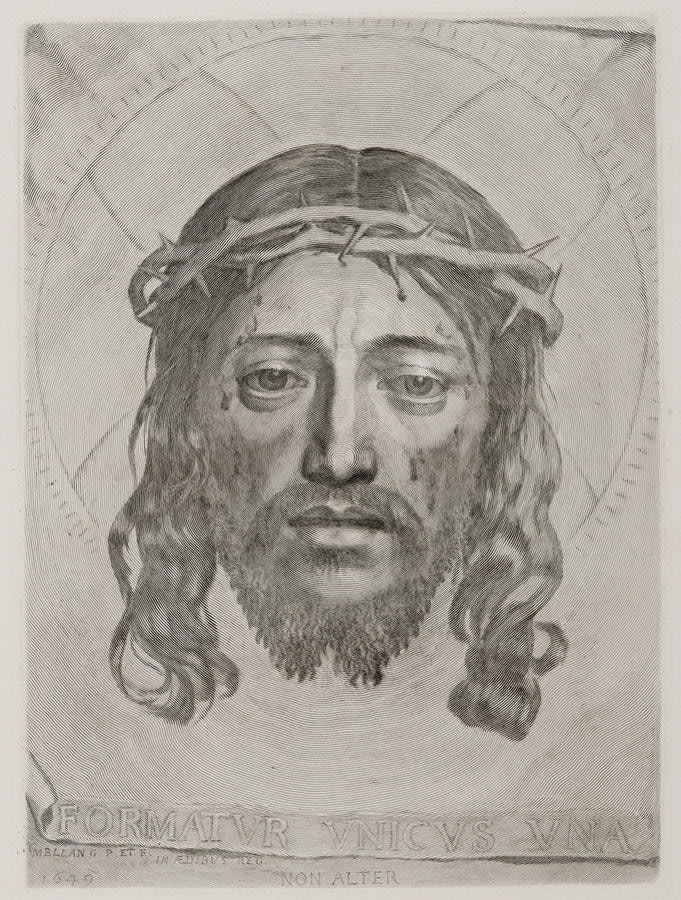 Claude Mellan – The Holy Face (1649)
Claude Mellan – The Holy Face (1649)
 László Moholy-Nagy – Selfportrait (1918)
László Moholy-Nagy – Selfportrait (1918)
 László Moholy-Nagy - Portrait of Herbert Bayer
László Moholy-Nagy - Portrait of Herbert Bayer
László Moholy-Nagy German School, 1895-1946
33.3 x 21 cm
Plus d'images
This recently rediscovered expressionist drawing by László Moholy-Nagy is part of a small group of drawings made by the artist early in his career, in Vienna and Berlin. The use of interlaced curves, typical of the artist's technique, gives this hieratic portrait a magnetic radiance, while the absence of any connection with the rest of the body evokes a profane Holy Face.
1. From Hungary to Chicago, the life of László Moholy-Nagy
Moholy-Nagy was born in Borsod, now known as Bácsborsód in Southern Hungary, in July 1895. He studied law in Budapest in 1913, when he was drafted into the Austro-Hungarian army to serve as an artillery officer on the Italian and Russian fronts. While serving at artillery observation posts, Moholy-Nagy did numerous drawings, recording his traumatic war experience, on the reverse of military-issued postcards which he could easily carry with him. In 1917, he was seriously wounded and hospitalized. The following year (around 1918 at the age of 23), he abandoned his plans to become a lawyer in favour of a career as an artist, with the encouragement of his friend, the art critic Iván Hevesy.
The drawings executed in those early years reveal Moholy-Nagy's powerful Expressionist lines. In his autobiography of 1944, Abstract of an Artist, Moholy-Nagy explained his early figurative style, writing that contemporary art in those days was too chaotic and that and all the '-isms' were incomprehensible and puzzling to him. However, in 1919, he was already experimenting with Dadaist compositions. He then moved to Vienna and later to Berlin, where he would soon make his first works in his Constructivist style of the early 1920s.
In Berlin he met photographer and writer Lucia Schultz who became his wife the following year. In 1922, he met Walter Gropius. During a vacation on the Rhone with Lucia, she showed him how to make photograms on light-sensitized paper. Walter Gropius invited him to teach at the Bauhaus in Weimar in 1923 where he replaced Paul Klee as Head of the Metal Workshop. The Bauhaus became known for the versatility of its artists and Moholy-Nagy was no exception: throughout his career, he became proficient in the fields of photography, typography, sculpture, painting, printmaking, film-making and industrial design.
In 1928 Moholy-Nagy left the Bauhaus and established his own design studio in Berlin. He separated from his first wide Lucia in 1929. In 1931, he met actress and scriptwriter Sibylle Pietzsch. They married in 1932 and had two daughters, Hattula (born 1933) and Claudia. After the Nazis came to power in Germany in 1933, he was no longer allowed to work there. He moved his family to London in 1935. In 1937, on the recommendation of Walter Gropius, Moholy-Nagy moved to Chicago to become the director of the New Bauhaus, but the school closed in 1938. Moholy-Nagy resumed doing commercial design work, which he continued for the rest of his life.
In 1939 Moholy-Nagy opened the School of Design in Chicago, which, in 1944, became the Institute of Design, and then part of the Illinois Institute of Technology in 1949. Diagnosed with leukaemia in 1945, Moholy-Nagy died of the disease in Chicago in 1946.
2. Description of the artwork
This drawing is a frontal representation of a man in his thirties, whose penetrating gaze seems to stare at us. The face is highly symmetrical and is modelled by curved black lines. The very high forehead and the slightly dilated left pupil reinforce the expressive character of the face.
Like the Holy Face which appeared on the cloth stretched out to wipe Christ's face by Saint Veronica, only the model's face is represented on the cardboard piece. The curved lines that define the face, hollowing out the temples, the eyelids, the cheeks and the area around the mouth, create a kind of magnetic radiation around a median point located between the eyebrows.
In some respects, this face may evoke one of the most famous representations of the Holy Face: the extraordinary engraving by Claude Mellan (1598 - 1688) which was engraved with a single rotating line starting from the tip of Christ's nose.
3. Related portraits
The technique of this drawing, based on the use of intersecting curves, evokes other portraits made by the artist in the years 1918-1920, starting with his 1918 self-portrait (sold by Sotheby's London for £145,200 on 23 June 2010).
Usually drawn with a wax crayon, sometimes with charcoal or graphite, the few portraits we have been able to find in the sale catalogues do not have the hieratic character of the one we are presenting: the sitter is generally represented in a three-quarter view, mid-bust.
We were unable to identify the sitter of our portrait. The narrow moustache and the flattened hair are typical of the male canons of the 1920s, as seen, for example, in this photographic portrait of Herbert Bayer (1900 - 1985), which Moholy-Nagy made a few years after our portrait.
4. Framing
To frame this portrait, we chose an early 20th-century flat frame in blackened wood and walnut rush, which confirms the portrait's hieratic character while adding a certain sophistication.









